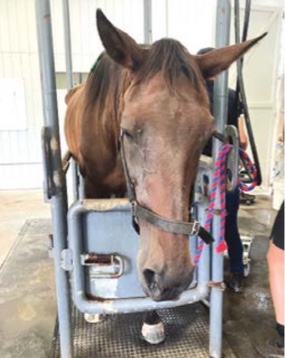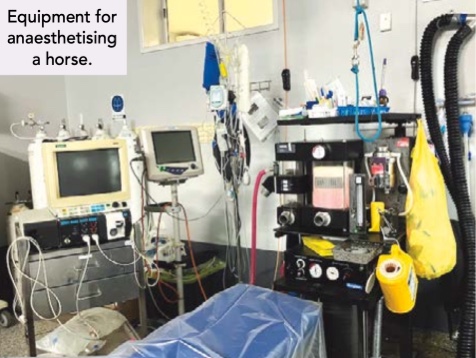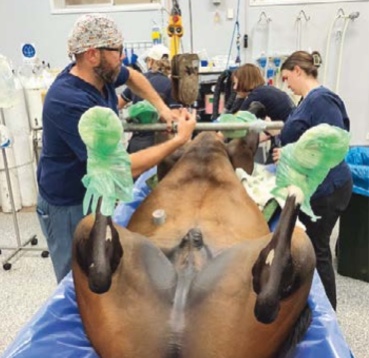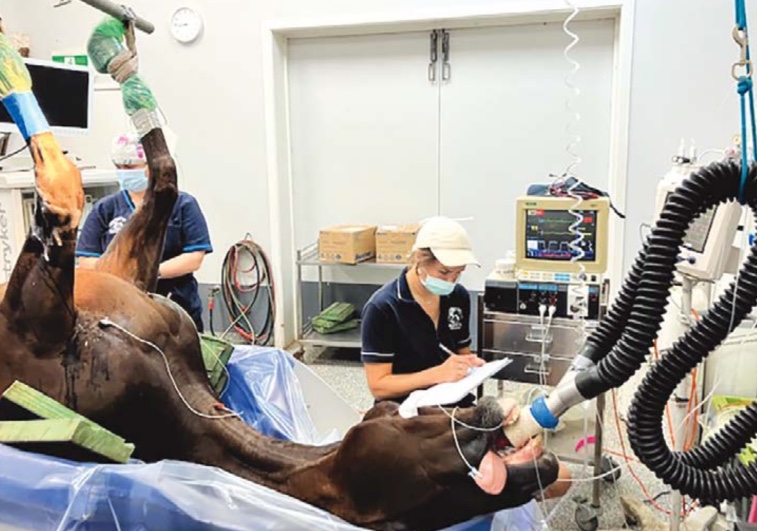The sedation and anaesthetising of horses to perform medical and surgical procedures is very commonly used by veterinarians in equine practice. Here, we are going to look at the history of their use, the common medications that are used and the potential risks associated with them. Only the more commonly used medications will be looked at as there are many variants, different medications and different combinations that may be used, particularly in hospitals and referral centres.
This a general article and doesn’t replace the opinion of the veterinarians attending your horse and the selection of drugs they use specific to that case. Sedatives, tranquilizers, local anaesthetics and general anaesthetics should only be prescribed and administered under the care of a licensed veterinarian.
Definitions
Sedation
The use of a drug to induce calmness or drowsiness. The horse is not fully unconscious and usually remains standing. Patients’ consciousness is only depressed through the drugs, so they cannot be easily aroused but can respond purposefully to stimuli.
Sedation is often used to perform minor procedures and some surgery procedures, for example, dentistry, endoscopy, gastroscopy, and rectal examination. Radiography and ultrasonography.
General Anaesthesia
Patients are given drugs to induce a temporary/reversible loss of consciousness, sensation and awareness, therefore reducing their response to painful stimuli. General anaesthesia is often used for invasive surgical procedures. Wherever possible, standing sedation is preferable as it avoids the risks associated with general anaesthesia but isn’t always possible from many surgical procedures.
Local and Regional Anaesthesia
This is desensitizing a region of the body (regional anaesthesia), for example,
the perineum with an epidural, or desensitizing a specific area of the body (local anaesthesia), for example, a limb with a laceration. Local and regional anaesthesia are often used in combination with sedation.
History of equine anaesthesia and sedation
Equine anaesthesia and sedation have been used in some manner since the 1500s, where there are reports of plant extracts being used, such as opium and cannabis. In 1540, the use of ether was reported, and anaesthesia was defined as “a defect in sensation.” There were key developments in the 1800s with drugs such as curare (muscle relaxant), chloroform and chloral hydrate introduced, and equipment developed. In the 1900s into the 2000s, there were advancing developments and publications in early veterinary journals and the introduction of more drugs (central muscle relaxants, α2 agonists as sedation and inhalational anaesthetics).
In the last 30 years, there has been some significant progression with improvement in designs of both anaesthetic machines and monitoring equipment specific to the horse, anaesthesia being taught as a considerable part of the veterinary curriculum, detailed anaesthetic records and the introduction of further, more specific medications. It is a very exciting and rapidly developing field within veterinary medicine, and some of the hospitals have specialists in equine anaesthesia.
What happens before sedation and anaesthesia of a horse?
The veterinarian will explain to you what is being used and the potential risks. For prolonged sedation and general anesthesia, just as in human medicine, you will be asked to sign a consent form. If you have questions about what is going to happen to your horse and the associated risks, then these can be discussed at that time.
Medical History
The veterinarian/anaesthetist will ask questions with regard to the horse’s medical history and check whether there are any preexisting conditions that can have an impact on sedation or anaesthesia. Some of the conditions that may have an influence are cardiac conditions, hyperkalemic periodic paralysis (HYPP), equine asthma, laryngeal paralysis, other cardiac issues, previous surgeries and any past issues with sedation or anaesthesia.
Certain procedures and types of horses have increased levels of anaesthetic risk and potential complications.
Preanaesthetic examination
The examination performed will be more thorough for general anaesthesia and prolonged standing sedation compared to short-standing sedation, the veterinarian will however perform a basic physical examination for both.
The veterinarian will assess the horse’s current condition and evaluates all body systems heart, lungs and musculoskeletal systems. In some cases, particularly where the horse is sick and has to undergo a procedure, then routine blood tests (haematology and biochemistry) will be performed to evaluate hydration, kidney and liver function, oxygenation of tissues and an underlying infection.
In some cases, advanced diagnostics may be used to evaluate the cardiovascular and respiratory systems.
Weigh the horse
If possible, the horse will be weighed to get an accurate weight but this is usually only possible at hospitals or for veterinarians that have portable scales. If they can’t be weighed, then an estimate is made, or a measuring tape may be used.



What are the risks associated with sedation and anaesthesia?
The drugs used have powerful effects on the different organ systems, including the brain, heart, circulatory system, lungs, kidneys, liver, and musculoskeletal system. The interaction of these medications with the body systems is complex and, on rare occasions, can be unpredictable, and as a consequence, there are possible risks and complications that can occur. Veterinarians are aware of these risks and act to manage and minimize them as best they can, but as with any medications or procedures, there is always an element of possible issues occurring. The veterinarian will explain these to you.
Risks and complications related to sedation
Allergic reactions
The veterinarian/anaesthetist will ask questions with regard to the horse’s medical history and check whether there are any preexisting conditions that can have an impact on sedation or anaesthesia. Some of the conditions that may have an influence are cardiac conditions, hyperkalemic periodic paralysis (HYPP), equine asthma, laryngeal paralysis, other cardiac issues, previous surgeries and any past issues with sedation or anaesthesia.
Collapse
The examination performed will be more thorough for general anaesthesia and prolonged standing sedation compared to short-standing sedation, the veterinarian will however perform a basic physical examination for both.
The veterinarian will assess the horse’s current condition and evaluates all body systems heart, lungs and musculoskeletal systems. In some cases, particularly where the horse is sick and has to undergo a procedure, then routine blood tests (haematology and biochemistry) will be performed to evaluate hydration, kidney and liver function, oxygenation of tissues and an underlying infection.
In some cases, advanced diagnostics may be used to evaluate the cardiovascular and respiratory systems.
Excitement
If possible, the horse will be weighed to get an accurate weight but this is usually only possible at hospitals or for veterinarians that have portable scales. If they can’t be weighed, then an estimate is made, or a measuring tape may be used.
Iatrogenic injury
Any procedure or medication involving horses, particularly young, unhandled and fractious horses, can result in accidental injury to the horse due to their prey response and high flight tendencies.
Risks and complications related to general anaesthesia
General anaesthesia is a relatively high-risk procedure in the horse, with worldwide studies showing an overall approximately 0.9 % peri-operative fatality rate in non-colic horses undergoing anaesthesia. There is a significant increase in risk for horses undergoing emergency surgery such as colic. Due to the effects of the drugs and the size and temperament of the horse, all general anaesthesia procedures do carry a risk. Certain procedures and types of horses have increased levels of anaesthetic risk and potential complications. It is important that, as an owner, you are aware of these risks.
The following lists the possible risks that can occur at any time through the general anaesthetic from induction during the procedure or in recovery. The consequence can be variable from minor to, on occasion, fatal. Veterinarians/ anaesthetists act to minimise and manage these potential risks. The possible complications include:
Cardiac arrest
Sedatives and anaesthetics depress the action of the heart, and on rare occasions, horses may be very sensitive to this effect and suffer a cardiac arrest. Despite attempts at cardiac resuscitation in the horse, which is difficult given their size, this can be fatal.
Myopathy/neuropathy
Horses have a very large muscle mass, and sometimes, there can be complications as a result of poor blood flow and pressure. The consequence depends on the extent of the damage. Veterinarians attempt to minimise risk by carefully positioning and padding on the operating table and using medications to maintain blood pressure.
Post anaesthetic colic
This may occur secondary to reduced gut motility, which is an effect of some of the drugs. It may vary in severity from mild and transient to fatal if there is a rupture.
Injuries
Because of the nature of the horse and the induction and recovery phases requiring the horse to lie down and stand up, sometimes skin, muscles, nerves, and eyes can be injured.
Fractures
Due to the size and temperament of the horse and the induction and recovery phases of anaesthesia, occasionally, horses can break bones. The recovery phase, where a horse attempts to stand while it is wobbly from the effects of the anaesthetic drugs, is when this is more likely to occur.
Iatrogenic injury
Any procedure involving horses, especially fractious, unhandled, or young horses, can result in accidental injury.
Predisposing factors to anaesthetic and sedation risks
Complications can occur with any horse, but the following are factors that increase the possibility of risk:
Age
Older/geriatric horses have an increased risk compared to younger horses. This is like the situation in older and younger people in terms of anaesthetic risk. Neonates (newborn foals) have immature organs and are more susceptible to risk
Duration of anaesthesia
Long anaesthetics (over 3 hours) have an increased risk of complications, including myopathy, fractures and death.
Sick horses
Horses that have underlying disease or illness have an increased risk.
Type of surgery
Emergency surgeries such as colic, fracture repair and caesarean section have increased risk.
Summary
Sedation and general anaesthesia are commonly used by veterinarians when performing procedures and surgery on the horse. They are used to help immobilize the horse and to reduce response to painful stimuli. Sedation and general anaesthesia in the horse should only be prescribed and administered under the care of a licensed veterinarian. As with any medication, due to the size of the horse and their temperament, there are risks of complications. Veterinarians attempt to minimize these risks by carefully selecting the drugs to be used, the environment in which they are performed and supportive medications. All risks will be explained by the veterinarian when they are sedating or anaesthetising your horse, and if you have any questions or concerns, then discuss them with the veterinarian to be sure you understand.

